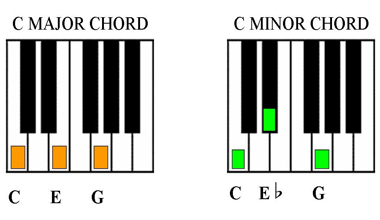Book Back Cover
v302
I
love the beautiful sound; that and the amazingly coherent
mathematical beauty that is the core of music theory; that and of
course the satisfaction, excitement and challenge of actually playing
piano by sight-reading classical sheet music that was written by the
likes of Beethoven and Mozart. And now with the internet, now is the
best time in history to learn!
I
love how eloquent and articulate classical sheet music “describes”
the intricacies of the sound of that piece of music. That and the
beauty of the simplicity of the black and white music notes on paper
spanning the ten lines and spaces of the Piano Grand Staff. All music
can be accurately translated into sheet music, which with
understanding of music theory, it is easy to learn to sight-read and
play on the piano. All sheet music is composed of simple
notation of whole, half, quarter and sixteenth notes, with some
rests, accidentals, dynamics and articulation notation thrown in here
and there (don't worry, this book teaches what all these fancy
music terminology means). Piano sheet music also features key &
times signatures, chords & arpeggios, finger numbers, slurs,
ties, sharps, flats, crescendos, diminuendos and staccatos, the
treble & bass clefs on the piano grand staff, measures and ledger lines, rhythms & harmonies, dotted notes, Major and minor Scales,
repeats, octaves and pedal cue marks. Not to mention that without
this 'written sheet music', we would not have any of the great
sonatas and symphonies of the Classical Era that were written more
than 200 years ago. These simple notations on paper immortalized the
classical music of the late great icons like Ludwig van Beethoven and
Wolfgang A Mozart... And the best part of learning to music theory
and to read sheet music is that there is an unlimited amount of sheet
music waiting for you online and at your local music stores. There is
more music than you could ever play in a lifetime! Your favorite
songs are waiting for you. It all starts in first grade music school. (oh and the best part is the more you learn, the better it gets!)
ADDING
YOUR OWN ARTISTIC COLOR TOUCH AS A GUIDE TO HELP YOU LEARN AND
SIGHT-READ. Good
old fashioned black and white, ink and paper sheet music is great
just as is. I don't want to change anything about the unadulterated
classic form of sheet music. I am not trying to re-invent classical
sheet music, I think of adding a personal touch of color as evolving
and improving upon the old.
This
“My Music in Color” Book in your hands is currently black and
white. You add the touch of color yourself as a learning tool and
sight-reading guide. Use
color to accentuate and emphasize the music. Make your own
personalized color code system, something that makes sense and works
for you. I like to color in the note tails of some pieces various
colors, or color all the lines blue and spaces red, making “skips”
and “steps” easier to read at a glance. Or some pieces I like to
color all C notes red, and all G sharps green or B flats orange. It
is completely up to you. Just highlight segments or the rhythms
phrases or just make it the music look pretty, whatever makes you
happy, and assists you in sight-reading faster and more effectively
than ever before. Be sure to enter “your” colored music into the
school contest for best Colored Sheet Music. Check out the BPS Color
Music Contest for ideas.
♪
♪ Meet Your 1st Grade Music
Teacher ♪ ♪
David
is a Sociologist and Scientist (Bachelors of Arts from the SUNY
Albany '07),
United
States Marine, Afghanistan War Veteran (Operation Enduring Freedom
'09),
Author
(library of works and website links at dwcoon.blogspot.com),
Teacher
at the Online Tutoring School, Piano Teacher at BPS,
ESL
Tutor, and a Computer and Info Sciences Teacher,
and an
entrepreneur of multiple other businesses.





